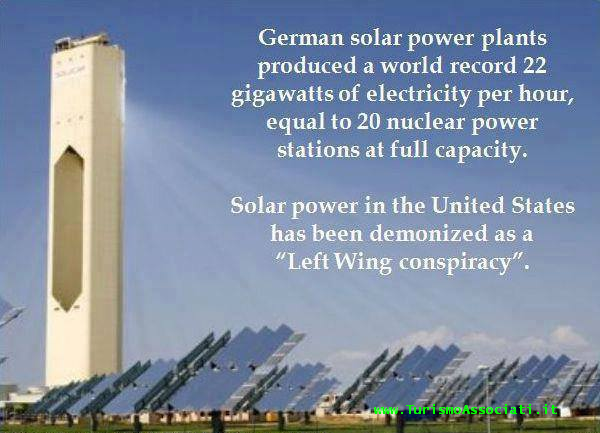Nuclear power produces nearly 20% of Germany's energy, but in July 2011 (only three months after Fukushima) the German government vowed to shut down its nuclear capability within 10 years. Not just that, but to replace it with renewable energy, cut greenhouse-gas (GHG) emissions by 40% by 2020 and 80% by 2050, ensure renewables contribute 80% of Germany's energy by 2050, and ensure energy consumption drops 20% by 2020 and 50% by 2050. It even has its own word: 'Energiewende', or 'Energy Transformation'. And Angela Merkel, not known for hyperbole, has described it as a 'Herculean task'.

Energiewende: persuading the public
But Professor Dr Manfred Fischedick is not a casual observer. As vice president of the Wuppertal Institute, he is scientific adviser to both policy makers and industry. Energiewende, he says, didn't simply fall from the sky in 2011. "Discussions about Energiewende had started already in the 1980s", says Fischedick. "There is a long tradition here in talking about alternative energy transformation. We had a lot of good scientific background and a very good basis for the government to come to such decisions in a very short timeframe... Just three months' discussion for such an ambitious energy concept would not have been possible without that."
Discussions are one thing. The reality, however, is proving quite another. "Now we have to construct new power lines, now people will see new biomass facilities very close to their houses, they will see new wind farms... the [crucial] social challenge is really to get public acceptance for all these many new investments."
The sight of thousands of kilometres of power cables slicing through the German countryside, and the costs involved, are beginning to bite. A renewable energy surcharge has already seen the average family's energy bill increase by 47% in the past two years.
There are also question marks over the transportation and storage of intermittent wind energy. However Fischedick argues that, "90% of the technologies are already available... our analysis is we [will need] more long-term storage systems after 2030. That's not a short-term challenge it is more of mid-to-long term. The short-term challenge is how to realise appropriate infrastructure on the electricity grid side... the main question at the moment is how we will be able to construct and get public acceptance for new power lines."
The prosumer model
While a lot of the media attention has been focused on large-scale wind farms (and Fischedick expects wind power to contribute half of the 80% renewable energy target by 2050), one of the most fascinating aspects of Energiewende is how it embraces micro-generation and micro-ownership. Public acceptance is, says Fischedick, much easier to maintain if it is paralleled with levels of individual ownership. Also known as a 'prosumer' model, over 50% of renewable-energy capacity is owned by individuals or farmers in Germany; the Big Four energy companies own just 6.5% (according to 2010 figures). "This is PV, co-generation... really small facilities," says Fischedick. "The prosumer aspect is vitally important... if you only have the chance to look from outside at the changes then you are much more [likely to be] complaining about what is going on."

This in turn is causing the big utility companies to reassess their role. Rather than continuing to rely on business-as-usual, they are significantly ramping up investment in biomass plants, offshore wind and large-scale photovoltaic plants, informs Fischedick. "In addition we have some utility companies looking at becoming a sort of service provider for the prosumer; RWE for instance provide a new service for the typical house owner to help them construct their own PV system on the roof, and to combine it with a small-scale battery. They have really changed their business portfolio in the last two years, just to be part of the game."
Changing mindsets
Despite the vast scale of the infrastructure and investment challenge, it is perhaps smaller than the more abstract task of changing people's lifestyles – which, Fischedick argues, has so far been avoided by the government. Reducing energy consumption by half cannot be done without changing consumer behaviour. This, says Fischedick, involves individuals being "more motivated to look at their own consumption of energy, because many people are not really aware of that... we have to explain that it is not enough to only invest in new insulation of buildings, but to combine it with appropriate and smart behaviour. That's a little bit connected with education... But also you have to discuss new forms of incentive systems, such as ecological taxes. It has not been discussed so far but I think it will be on the table in the next couple of years."
The rising cost of energy – in a country that already has the second highest energy bills in Europe – need not be the insurmountable barrier to Energiewende that some have suggested, says Fischedick. "The final energy bill is the most important aspect, not the increase in a specific price of kilowatt hours or cubic meters of gas. In combination with more investment in energy-efficient technologies, it is not necessarily the case that the energy bill will increase. It is that context that we have to really teach consumers".
That message is currently failing to reach consumers by being too meekly conveyed, says Fischedick. If there is a barrier to Energiewende, he believes it is perversely the very politicians that initiated it. "In the context of the EU directive for energy efficiency, it was the German government who tried to make this directive weaker than it was proposed by the Commission... we have specific goals and a concept, but the real behaviour of the government is at the moment quite different."
Perhaps the politicians could be forgiven a little wobble. To describe Germany's energy transformation as Herculean also serves to highlight its potential heroism – doing with urgency what most of the rest of the world is only saying is urgent. This could well see other countries playing catch up once again to the economic powerhouse of Europe. But with only seven years left to decommission 17 nuclear power plants, cut GHG emissions by 40% and energy consumption by 20%, it has a lot to do. And fast.
Source: This content is brought to you by Guardian Sustainable Business in association with Accenture. Paid for by Accenture. All editorial controlled and overseen by the Guardian.co.uk .